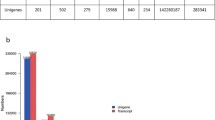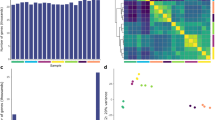Abstract
Heteromorphic self-incompatibility systems provide an excellent model for studying both intraspecific breeding barriers and the regulation of floral organ size and positioning, yet at the molecular level, they are almost completely uncharacterized. In this study, a subtracted cDNA library was generated from developing and mature floral tissues of the thrum morph of Primula vulgaris, subtracted with the same tissues from the pin morph. Differential screening and reverse transcriptase-polymerase chain reaction analysis identified 11 classes of cDNA that were differentially expressed between developing floral morphs. A number of these classes have significant homology to members of gene families implicated in plant development, including rapid alkalinization factors, DExH box RNA helicases, SKS multi-copper oxidases, and AtCHX ion-transporter families, consistent with their potential involvement in the regulation of floral heteromorphy. None of the cDNAs identified appear to be linked to the Primula S-locus suggesting that they are not components of the S-locus itself, and are more likely downstream components of developmental pathways leading to floral heteromorphy.



Similar content being viewed by others
References
Albani D, Sardana R, Robert LS, Altosaar I, Arnison PG, Fabijanski SF (1991) A Brassica napus gene family which shows sequence similarity to ascorbate oxidase is expressed in developing pollen—molecular characterization and analysis or promoter activity in transgenic tobacco plants. Plant J 2:331–342
Al Wadi H, Richards AJ (1993) Primary homostyly in Primula L. subgenus Sphondylia (Dudy) Rupr. and the evolution of distyly in Primula. New Phytol 124:339–338
Anthanasiou A, Khosravi D, Shore JS (2003) Characterization and localization of short-specific polygalacturonase in distylous Turnera subulata (Turneraceae). Am J Bot 90:675–682
Barbacar N, Hinnisdaels S, Farbos I, Monéger F, Lardon A, Delichère C, Mouras A, Negrutiu I (1997) Isolation of early genes expressed in reproductive organs of the dioecious white campion (Silene latifolia) by subtraction cloning using an asexual mutant. Plant J 12:805–817
Barrett SCH (1988) The evolution, functioning and breakdown of heteromorphic incompatibility systems. In: Lovett Doust J, Lovett Doust L (eds) Plant reproductive ecology, patterns and strategies. Oxford University Press, New York, pp 98–124
Barrett SCH, Cruzan MB (1994) Incompatibility in heterostylous plants. In: Williams EG (ed) Genetic control of self-incompatibility and reproductive development in flowering plants. Kluwer Academic Publishers, Dordrech, pp 189–229
Bedinger P, Parsons P, Clark M, Covey P, Arthur-Asmah R (2003) PEX proteins, pollen specific LRX (Leucine Rich Repeat Extensin Chimera) proteins. In: Proceedings of the 7th international congress on plant molecular biology. Barcelona, Spain, pp S20–S69
Bosch M, Hepler PK (2005) Silencing of tobacco pollen pectin methylesterase NtPPME1 results in retarded in vivo pollen tube growth. Planta 17:3219–3226
Charlesworth D, Vekemans X, Castric V, Glemin S (2005) Plant self-incompatibility systems: a molecular evolutionary perspective. New Phytol 168:61–69
Cheng Y, Chen X (2004) Posttranscriptional control of plant development. Curr Opin Plant Biol 7:20–25
Cock JM, McCormick S (2001) A large family of genes that share homology with CLAVATA3. Plant Physiol 126:939–994
Darwin C (1862) On the two forms, or dimorphic conditions, in the species of Primula, and on their remarkable sexual relations. Proc Linn Soc (Bot) 6:105–139
Dowd PE, McCubbin AG, Wang X, Verica JA, Tsukamoto T, Ando T, Kao T-h (2000) Use of Petunia inflata as a model for the study of solanaceous type self-incompatibility. Ann Bot 85(Suppl. A):87–93
Dowrick VPJ (1956) Heterosyly and homostyly in Primula obonica. Heredity 10:219–236
Fisher RA, Mather K (1943) Inheritance of style length in Lythrum salicaria. Ann Eugen 12:1–12
Fobis-Loisy I, Miege C, Gaude T (2004) Molecular evolution of the S locus controlling mating in the Brassicaceae. Plant Biol 6:109–118
Ganders FR (1979) The biology of heterostyly. NZ J Bot 17:607–635
Germain H, Chevalier E, Caron S, Matton DP (2005) Characterization of five RALF-like genes from Solanum chacoense provides support for a developmental role in plants. Planta 220:447–454
Gibbs PE (1986) Do homomorphic and heteromorphic self-incompatibility systems have the same sporophytic mechanism? Plant Syst Evol 154:285–323
de Groot P, Weterings K, de Been M, Witnik F, Hulznik R, Custers J, van Herpen M, Wullems G (2004) Silencing of a pollen-specific gene NTP303 and its family members in tobacco affects in vivo pollen tube growth and results in male sterile plants. Plant Mol Biol 55:715–726
Heslop-Harrison Y, Heslop-Harrison J, Shivanna KR (1981) Heterostyly in Primula. 1. Fine-structural and cytochemical features of the stigma and style in Primula vulgaris Huds. Protoplasma 107:171–187
Hildebrand F (1864) Botanisches Zeitung. January 1st 1864. Quoted by Darwin (1877)
Jacobs J, Roe JL (2005) SKS6, a multicopper oxidase-like gene, participates in cotyledon vascular patterning during Arabidopsis thaliana development. Planta 222:652–666
Jacobsen SE, Running MP, Meyerowitz EM (1999) Disruption of an RNA helicase/RNAse III gene in Arabidopsis causes unregulated cell division in floral meristems. Development 126:5231–5243
Kao T-h, Tsukamoto T (2004) The molecular and genetic bases of S-RNase-based self-incompatibility. Plant Cell 16(Suppl.):S72–S83
Kiyosue T, Yamaguchi-Shinozaki K, Shinozaki K (1994) Cloning of cDNAs for genes that are early-responsive to dehydration stress (ERDs) in Arabidopsis thaliana L.: identification of three ERDs as HSP cognate genes. Plant Mol Biol 25:791–798
Kramer EM, Hall JC (2005) Evolutionary dynamics of genes controlling floral development. Curr Opin Plant Biol 8:13–18
Kurian V, Richards AJ (1997) A new recombinant in the ‘S’ supergene in Primula. Heredity 78:383–390
Lacoux JL, Gutierrez L, Dantin F, Beaudoin B, Roger D, Laine E (2003) Antisense transgenesis of tobacco with a flax pectin methylesterase affects pollen ornamentation. Protoplasma 222:205–209
Lee M, Macmillan JD (1970) Mode of action of pectic enzymes. III. Sites of action of tomato pectin esterase on highly esterified pectin. Biochemistry 9:1930–1934
Lewis D (1949) Incompatibility in flowering plants. Biol Rev 24:472–496
Lorkovic ZJ, Barta A (2002) Genome analysis: RNA recognition motif (RRM) and K homology (KH) domain RNA-binding proteins from the flowering plant Arabidopsis thaliana. Nucleic Acids Res 30:623–635
Lukyanov K, Gurskaya N, Sverdlov ED, Sievert PD (1996) Suppression hybridization: a new method for generating differentially regulated or tissue specific probes and libraries. Proc Natl Acad Sci USA 93:6025–6030
Manfield IW, Pavlov VK, Li J, Cook HE, Hummel F, Gilmartin PM (2005) Molecular characterization of DNA sequences from the Primula vulgaris S-locus. J Exp Bot 56:1177–1188
McCubbin AG, Wang X, Kao T-h (2000) The use of differential display to identify cDNA markers at the S-locus of Petunia inflata. Genome 43:619–627
Nari J, Noat G, Ricard J (1992) Pectin methylesterase, metal ions and plant cell wall extension. Biochemistry 279:343–350
de Nettancourt D (1977) Incompatibility in angiosperms. Springer, Berlin Heidelberg New York
Olsen AN, Mundy J, Skriver K (2002) Peptomics, identification of novel cationic Arabidopsis peptides with conserved sequence motifs. In Silico Biol 2:441–451
Ornduff R (1979) Pollen flow in a population of Primula vulgaris Huds. Bot J Linn Soc 78:1–10
Pearce G, Moura DS, Stratmann J, Ryan CA (2001) RALF, a 5-kDa ubiquitous polypeptide in plants, arrests root growth and development. Proc Natl Acad Sci USA 98:12843–12847
Piper JG, Charlesworth B, Charlesworth D (1986) Breeding system evolution in Primula vulgaris and the role of reproductive assurance. Heredity 56:207–217
Richards AJ (1986) Plant breeding systems, 1st edn. Allen and Unwin, London
Richards AJ (1997) Plant breeding systems, 2nd edn. Allen and Unwin, London
Sedbrook JC, Carroll KL, Hung KF, Masson PH, Somerville CR (2002) The Arabidopsis SKU5 gene encodes an extracellular glycosyl phosphatidylinositol-anchored glycoprotein involved in directional root growth. Plant Cell 14:1635–1648
Shiu SH, Bleecker AB (2001) Plant receptor-like kinase gene family: diversity, function, and signaling 113:RE22
Stebbins GL (1950) Variation and evolution in plants. Columbia University Press, New York
Sze H, Padmanaban S, Cellier F, Honys D, Cheng N-H, Bock KW, Conéjéri G, Li X, Twell D, Ward JM, Hirschi KD (2004) Expression patterns of a novel AtCHX gene family highlight potential roles in osmotic adjustment and K+ homeostasis in pollen development. Plant Physiol 136:2532–2547
Tamari F, Shore JS (2004) Distribution of style and pollen polygalacturonases among distylous and homostylous Turnera and Piriqueta spp. (Turneraceae). Heredity 92:380–385
Veena, Reddy VS, Sopory SK (1999) Glyoxalase I from Brassica juncea: molecular cloning, regulation and its over-expression confer tolerance in transgenic tobacco under stress. Plant J 18:231
Wakeley PR, Rogers HJ, Rozycka M, Greenland AJ, Hussey PJ (1998) A maize pollen specific pectin methyl esterase-like gene, ZmC5, specifically expressed in pollen. Plant Mol Biol 37:187–192
Western TL, Cheng Y, Chen X (2002) HUA ENHANCER2, a putative DExH-box RNA helicase, maintains homeotic B and C gene expression in Arabidopsis. Development 129:1569–1581
Weterings K, Reijnen W, van Aarsen R, Kortstee A, Spijkers J, van Herpen M, Schrauwen J, Wullems G (1992) Characterization of a pollen-specific cDNA clone from Nicotiana tabacum expressed during male gametogenesis and germination. Plant Mol Biol 18:1101–1111
Wittink FRA, Knuiman B, Derksen J, Capkova V, Twell D, Schrauwen D, Schrauwen JAM, Wullems G (2000) The pollen-specific gene NTP303 encodes a 69-kDA glycoprotein associated with the vegetative membranes and the cell wall. Sex Plant Reprod 12:276–284
Woo SS, Jiang J, Gill BS, Paterson AH, Wing RA (1994) Construction and characterization of a bacterial artificial chromosome library of Sorghum bicolor. Nucleic Acids Res 22:4922–4931
Zik M, Irish VF (2003) Flower development: initiation, differentiation, and diversification. Annu Rev Cell Dev Biol 19:119–140
Acknowledgments
This work was supported using start-up funds from the College of Sciences, Washington State University and from the Center for Reproductive Biology, Washington State University.
Author information
Authors and Affiliations
Corresponding author
Additional information
Communicated by Teh-hui Kao
Rights and permissions
About this article
Cite this article
McCubbin, A.G., Lee, C. & Hetrick, A. Identification of genes showing differential expression between morphs in developing flowers of Primula vulgaris . Sex Plant Reprod 19, 63–72 (2006). https://doi.org/10.1007/s00497-006-0022-8
Received:
Accepted:
Published:
Issue Date:
DOI: https://doi.org/10.1007/s00497-006-0022-8




